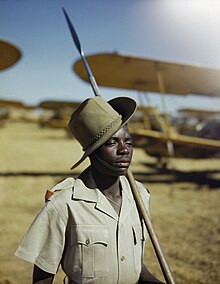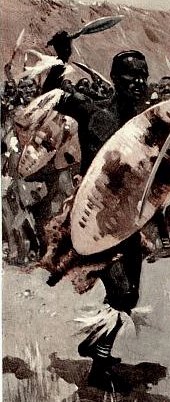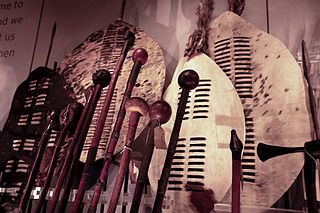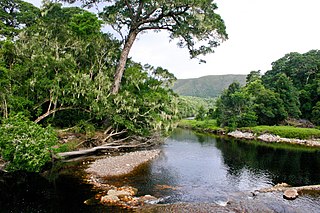This article needs additional citations for verification .(April 2019) |

An assegai or assagai [a] [2] is a polearm used for throwing, usually a light spear or javelin made up of a wooden handle with an iron tip.
This article needs additional citations for verification .(April 2019) |

An assegai or assagai [a] [2] is a polearm used for throwing, usually a light spear or javelin made up of a wooden handle with an iron tip.
The use of various types of the assegai was widespread all over Africa and it was the most common weapon used before the introduction of firearms. The Zulu, Xhosa, and other Nguni tribes of South Africa were renowned for their use of the assegai.

Shaka of the Zulu popularized the use of the shorter stabbing spear with a 610 mm (24 in) shaft and a larger, broader blade 300 mm (12 in) long in warfare, which was traditionally used primarily as a hunting spear. This weapon is otherwise known as the iklwa or ixwa, after the sound that was heard as it was withdrawn from the victim's wound. [3] [4] The traditional spear was not abandoned, but was thrown from range at enemy formations before closing in for close quarters battle with the iklwa. This tactical combination originated during Shaka's military reforms. This weapon was typically used with one hand while the off-hand held a cowhide shield for protection.
It is also the name of a southern African tree (Curtisia dentata) whose wood was suitable for making spears or lances, most notably by the Bantu-speaking people of southern Africa.

Impi is a Nguni word meaning war or combat and by association any body of men gathered for war, for example impi ya masosha is a term denoting an army. Impi were formed from regiments from large militarised homesteads. In English impi is often used to refer to a Zulu regiment, which is called an ibutho in Zulu, or the army of the Zulu Kingdom.

Shaka kaSenzangakhona, also known as Shaka Zulu and Sigidi kaSenzangakhona, was the king of the Zulu Kingdom from 1816 to 1828. One of the most influential monarchs of the Zulu, he ordered wide-reaching reforms that reorganized the military into a formidable force.
A spear is a polearm consisting of a shaft, usually of wood, with a pointed head. The head may be simply the sharpened end of the shaft itself, as is the case with fire hardened spears, or it may be made of a more durable material fastened to the shaft, such as bone, flint, obsidian, copper, bronze, iron, or steel. The most common design for hunting and/or warfare, since ancient times has incorporated a metal spearhead shaped like a triangle, diamond, or leaf. The heads of fishing spears usually feature multiple sharp points, with or without barbs.

Zulu people are a native people of Southern Africa of the Nguni. The Zulu people are the largest ethnic group and nation in South Africa, living mainly in the province of KwaZulu-Natal.

The Anglo-Zulu War was fought in present-day South Africa from January to early July 1879 between forces of the British Empire and the Zulu Kingdom. Two famous battles of the war were the Zulu victory at Isandlwana and the British defence at Rorke's Drift.

Curtisia dentata is a flowering tree from Southern Africa. It is the sole species in genus Curtisia, which was originally classed as a type of "dogwood" (Cornaceae), but is now placed in its own unique family Curtisiaceae.

The Battle of Isandlwana on 22 January 1879 was the first major encounter in the Anglo-Zulu War between the British Empire and the Zulu Kingdom. Eleven days after the British invaded Zululand in Southern Africa, a Zulu force of some 20,000 warriors attacked a portion of the British main column consisting of approximately 1,800 British, colonial and native troops with approximately 350 civilians. The Zulus were equipped mainly with the traditional assegai iron spears and cow-hide shields, but also had a number of muskets and antiquated rifles.

The Ndwandwe–Zulu War of 1817–1819 was a war fought between the expanding Zulu Kingdom and the Ndwandwe tribe in South Africa.

The Battle of Gqokli Hill has been claimed by some to have occurred on or around April 1818, a part of the Ndwandwe-Zulu War between Shaka of the Zulu nation and Zwide of the Ndwandwe just south of present-day Ulundi. However, some claim that the battle never actually happened.

Lobengula Khumalo was the second and last official king of the Northern Ndebele people. Both names in the Ndebele language mean "the men of the long shields", a reference to the Ndebele warriors' use of the Nguni shield.

A knobkerrie, also spelled knobkerry, knobkierie, and knopkierie (Afrikaans), is a form of wooden club, used mainly in Southern Africa and Eastern Africa. Typically they have a large knob at one end and can be used for clubbing an enemy's head. For the various peoples who use them, they often have marked cultural significance. Being able to carry the knobkerrie has also had a political dimension, especially in South Africa.

The Knysna–Amatole montane forests ecoregion, of the tropical and subtropical moist broadleaf forests biome, is in South Africa. It covers an Afromontane area of 3,100 square kilometres (1,200 sq mi) in the Eastern Cape and Western Cape provinces.

The Natal Native Contingent was a large force of auxiliary soldiers in British South Africa, forming a substantial portion of the defence forces of the British colony of Natal. The Contingent saw action during the 1879 Anglo-Zulu War. The Natal Mounted Police was created in 1873 to bolster the defenses of Natal. It enlisted European officers, NCOs and natives. The infantry was created in 1878. Most enlisted troops were drawn from the Basuto and Mpondo tribes, which had had long experience fighting the Zulus.
The military history of South Africa chronicles a vast time period and complex events from the dawn of history until the present time. It covers civil wars and wars of aggression and of self-defence both within South Africa and against it. It includes the history of battles fought in the territories of modern South Africa in neighbouring territories, in both world wars and in modern international conflicts.

A javelin is a light spear designed primarily to be thrown, historically as a ranged weapon. Today, the javelin is predominantly used for sporting purposes such as the javelin throw. The javelin is nearly always thrown by hand, unlike the sling, bow, and crossbow, which launch projectiles with the aid of a hand-held mechanism. However, devices do exist to assist the javelin thrower in achieving greater distances, such as spear-throwers or the amentum.

The Zulu Kingdom, sometimes referred to as the Zulu Empire, was a monarchy in Southern Africa. During the 1810s, Shaka established a standing army that consolidated rival clans and built a large following which ruled a wide expanse of Southern Africa that extended along the coast of the Indian Ocean from the Tugela River in the south to the Pongola River in the north.

African military systems (1800–1900) refers to the evolution of military systems on the African continent after 1800, with emphasis on the role of indigenous states and peoples within the African continent. Only major military systems or innovations and their development after 1800 are covered here. For events prior to 1800, see African military systems to 1800. Coverage of the late 19th/20th century and beyond is provided in African military systems after 1900. For an overall view of the military history of Africa by region, see Military History of Africa. See individual battles, empires and leaders for details on activities after 1800.
Deadliest Warrior premiered on April 7, 2009 at 10 pm ET. Nine one-hour episodes of the show were produced for Season 1. Season 1 was released on DVD and Blu-ray on May 11, 2010.
An assegai is a type of spear.

A Nguni shield is a traditional, pointed oval-shaped, ox or cowhide shield which is used by various ethnic groups among the Nguni people of southern Africa. Currently it is used by diviners or for ceremonial and symbolic purposes, and many are produced for the tourist market. A cow-hide shield is known as isihlangu, ihawu or ingubha in Zulu, and ikhaka or ikhawu in Xhosa.